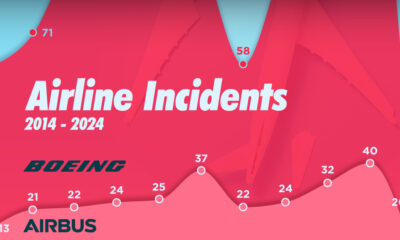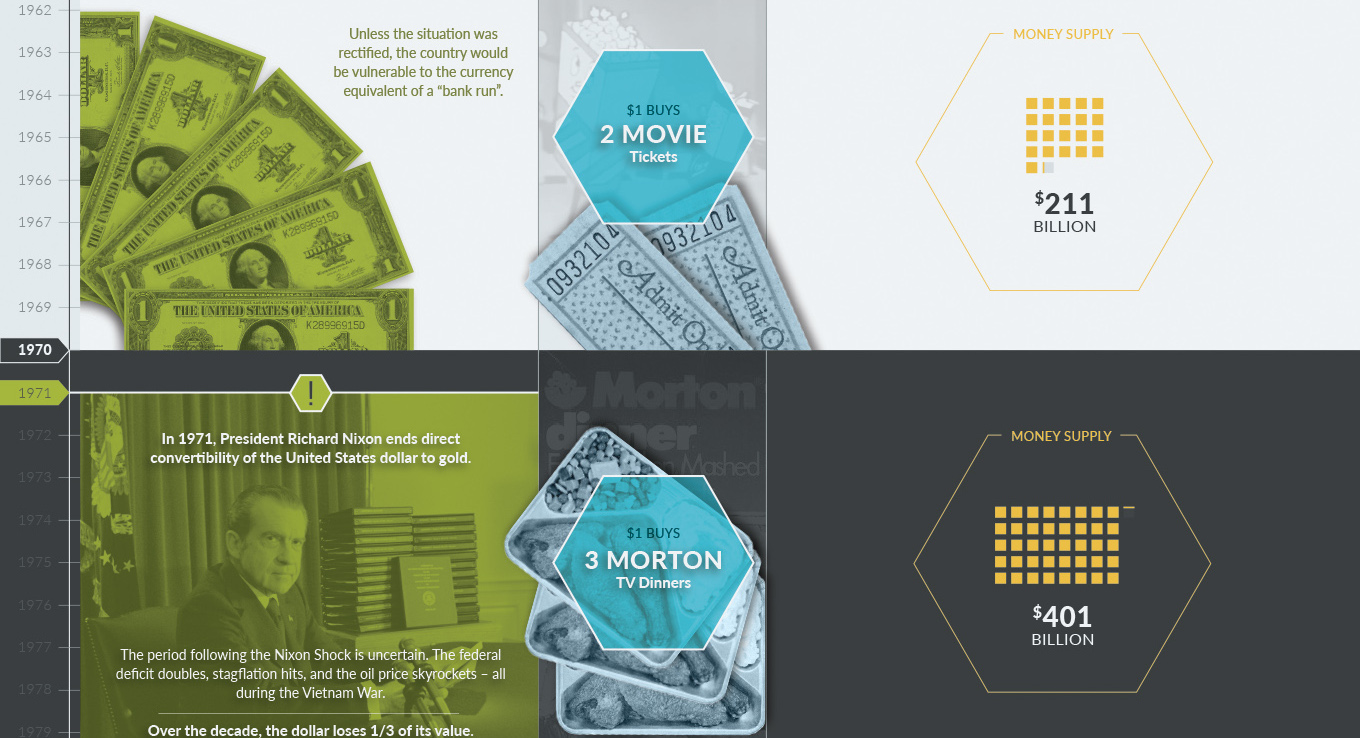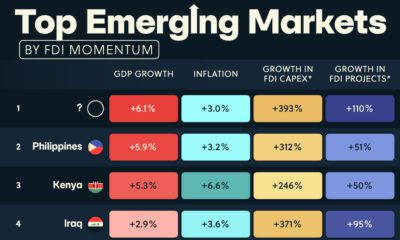Markets
Visualizing the Buying Power of the U.S. Dollar Over the Last Century

The Buying Power of the U.S. Dollar Over the Last Century
The Money Project is an ongoing collaboration between Visual Capitalist and Texas Precious Metals that seeks to use intuitive visualizations to explore the origins, nature, and use of money.
The value of money is not static. In the short term, it may ebb and flow against other currencies on the market. In the long-term, a currency tends to lose buying power over time through inflation, and as more currency units are created.
Inflation is a result of too much money chasing too few goods – and it is often influenced by government policies, central banks, and other factors. In this short timeline of monetary history in the 20th century, we look at major events, the change in money supply, and the buying power of the U.S. dollar in each decade.
A Short Timeline of U.S. Monetary History
1900s
After the Panic of 1907, the National Monetary Commission is established to propose legislation to regulate banking.
U.S. Money Supply: $7 billion
What $1 Could Buy: A pair of patent leather shoes.
1910s
The Federal Reserve Act is signed in 1913 by President Woodrow Wilson.
U.S. Money Supply: $13 billion
What $1 Could Buy: A woman’s house dress.
1920s
U.S. dollar bills were reduced in size by 25%, and standardized in terms of design.
The Fed starts using open market operations as a tool for monetary policy.
U.S. Money Supply: $35 billion
What $1 Could Buy: Five pounds of sugar.
1930s
To deal with deflation during the Great Depression, the United States suspends the gold standard. President Franklin D. Roosevelt signs Executive Order 6102, which criminalizes the possession of gold.
By no longer allowing gold to be legally redeemed, this removes a major constraint on the Fed, which can now control the money supply.
U.S. Money Supply: $46 billion
What $1 Could Buy: 16 cans of Campbell’s Soup
1940s
The massive deficits of World War II are almost financed entirely by the creation of new money by the Federal Reserve.
Interest rates are pegged low at the request of the Treasury.
Under Bretton-Woods, the “gold-exchange standard” is adopted.
U.S. Money Supply: $55 billion
What $1 Could Buy: 20 bottles of Coca-Cola
1950s
The Korean War starts in 1950, and inflation is at an annualized rate of 21%.
The Fed can no longer manage such low interest rates, and tells the Treasury that it can “no longer maintain the existing situation”.
U.S. Money Supply: $151 billion
What $1 Could Buy: One Mr. Potato Head
1960s
An agreement, called the Treasury-Federal Reserve Accord, is reached to establish the central bank’s independence.
By this time, U.S. dollars in circulation around the world exceeded U.S. gold reserves. Unless the situation was rectified, the country would be vulnerable to the currency equivalent of a “bank run”.
U.S. Money Supply: $211 billion
What $1 Could Buy: Two movie tickets.
1970s
In 1971, President Richard Nixon ends direct convertibility of the United States dollar to gold.
The period following the Nixon Shock is uncertain. The federal deficit doubles, stagflation hits, and the oil price skyrockets – all during the Vietnam War.
Over the decade, the dollar loses 1/3 of its value.
U.S. Money Supply: $401 billion
What $1 Could Buy: Three Morton TV dinners.
1980s
The stock market crashes in 1987 on Black Monday.
The Federal Reserve, under newly-appointed Alan Greenspan, issues the following statement:
“The Federal Reserve, consistent with its responsibilities as the nation’s central bank, affirmed today its readiness to serve as a source of liquidity to support the economic and financial system.”
The Dow would recover by 1989, with no prolonged recession occurring.
U.S. Money Supply: $1,560 billion
What $1 Could Buy: One bottle of Heinz Ketchup.
1990s
This decade is generally considered to be a time of declining inflation and the longest peacetime economic expansion in U.S. history.
During this decade, many improvements are made to U.S. paper currency to prevent counterfeiting. Microprinting, security thread, and other features are used.
U.S. Money Supply: $3,277 billion
What $1 Could Buy: One gallon of milk.
2000s
After the Dotcom crash, the Fed drops interest rates to near all-time lows.
In 2008, the Financial Crisis hits and the Fed begins “quantitative easing”. Later, this would be known as QE1.
U.S. Money Supply: $4,917 billion
What $1 Could Buy: One Wendy’s hamburger.
2010-
After QE1, the Fed holds $2.1 trillion of bank debt, mortgage-backed securities, and Treasury notes. Shortly after, QE2 starts.
In 2012, it’s time for QE3.
Purchases were halted in October 2014 after accumulating $4.5 trillion in assets.
U.S. Money Supply: $13,291 billion
What $1 Could Buy: One song from iTunes.
The Changing Value of a Dollar
At the turn of the 20th century, the money supply was just $7 billion. Today there are literally 1,900X more dollars in existence.
While economic growth has meant we all make many more dollars today, it is still phenomenal to think that during past moments in the 20th century, a dollar could buy a pair of leather shoes or a women’s house dress.
The buying power of a dollar has changed significantly over the last century, but it’s important to recognize that it could change even faster (up or down) under the right economic circumstances.
About The Money Project
The Money Project is an ongoing collaboration between Visual Capitalist and Texas Precious Metals that seeks to use intuitive visualizations to explore the origins, nature, and use of money.
Markets
U.S. Debt Interest Payments Reach $1 Trillion
U.S. debt interest payments have surged past the $1 trillion dollar mark, amid high interest rates and an ever-expanding debt burden.

U.S. Debt Interest Payments Reach $1 Trillion
This was originally posted on our Voronoi app. Download the app for free on iOS or Android and discover incredible data-driven charts from a variety of trusted sources.
The cost of paying for America’s national debt crossed the $1 trillion dollar mark in 2023, driven by high interest rates and a record $34 trillion mountain of debt.
Over the last decade, U.S. debt interest payments have more than doubled amid vast government spending during the pandemic crisis. As debt payments continue to soar, the Congressional Budget Office (CBO) reported that debt servicing costs surpassed defense spending for the first time ever this year.
This graphic shows the sharp rise in U.S. debt payments, based on data from the Federal Reserve.
A $1 Trillion Interest Bill, and Growing
Below, we show how U.S. debt interest payments have risen at a faster pace than at another time in modern history:
| Date | Interest Payments | U.S. National Debt |
|---|---|---|
| 2023 | $1.0T | $34.0T |
| 2022 | $830B | $31.4T |
| 2021 | $612B | $29.6T |
| 2020 | $518B | $27.7T |
| 2019 | $564B | $23.2T |
| 2018 | $571B | $22.0T |
| 2017 | $493B | $20.5T |
| 2016 | $460B | $20.0T |
| 2015 | $435B | $18.9T |
| 2014 | $442B | $18.1T |
| 2013 | $425B | $17.2T |
| 2012 | $417B | $16.4T |
| 2011 | $433B | $15.2T |
| 2010 | $400B | $14.0T |
| 2009 | $354B | $12.3T |
| 2008 | $380B | $10.7T |
| 2007 | $414B | $9.2T |
| 2006 | $387B | $8.7T |
| 2005 | $355B | $8.2T |
| 2004 | $318B | $7.6T |
| 2003 | $294B | $7.0T |
| 2002 | $298B | $6.4T |
| 2001 | $318B | $5.9T |
| 2000 | $353B | $5.7T |
| 1999 | $353B | $5.8T |
| 1998 | $360B | $5.6T |
| 1997 | $368B | $5.5T |
| 1996 | $362B | $5.3T |
| 1995 | $357B | $5.0T |
| 1994 | $334B | $4.8T |
| 1993 | $311B | $4.5T |
| 1992 | $306B | $4.2T |
| 1991 | $308B | $3.8T |
| 1990 | $298B | $3.4T |
| 1989 | $275B | $3.0T |
| 1988 | $254B | $2.7T |
| 1987 | $240B | $2.4T |
| 1986 | $225B | $2.2T |
| 1985 | $219B | $1.9T |
| 1984 | $205B | $1.7T |
| 1983 | $176B | $1.4T |
| 1982 | $157B | $1.2T |
| 1981 | $142B | $1.0T |
| 1980 | $113B | $930.2B |
| 1979 | $96B | $845.1B |
| 1978 | $84B | $789.2B |
| 1977 | $69B | $718.9B |
| 1976 | $61B | $653.5B |
| 1975 | $55B | $576.6B |
| 1974 | $50B | $492.7B |
| 1973 | $45B | $469.1B |
| 1972 | $39B | $448.5B |
| 1971 | $36B | $424.1B |
| 1970 | $35B | $389.2B |
| 1969 | $30B | $368.2B |
| 1968 | $25B | $358.0B |
| 1967 | $23B | $344.7B |
| 1966 | $21B | $329.3B |
Interest payments represent seasonally adjusted annual rate at the end of Q4.
At current rates, the U.S. national debt is growing by a remarkable $1 trillion about every 100 days, equal to roughly $3.6 trillion per year.
As the national debt has ballooned, debt payments even exceeded Medicaid outlays in 2023—one of the government’s largest expenditures. On average, the U.S. spent more than $2 billion per day on interest costs last year. Going further, the U.S. government is projected to spend a historic $12.4 trillion on interest payments over the next decade, averaging about $37,100 per American.
Exacerbating matters is that the U.S. is running a steep deficit, which stood at $1.1 trillion for the first six months of fiscal 2024. This has accelerated due to the 43% increase in debt servicing costs along with a $31 billion dollar increase in defense spending from a year earlier. Additionally, a $30 billion increase in funding for the Federal Deposit Insurance Corporation in light of the regional banking crisis last year was a major contributor to the deficit increase.
Overall, the CBO forecasts that roughly 75% of the federal deficit’s increase will be due to interest costs by 2034.
-

 Travel1 week ago
Travel1 week agoAirline Incidents: How Do Boeing and Airbus Compare?
-

 Markets3 weeks ago
Markets3 weeks agoVisualizing America’s Shortage of Affordable Homes
-

 Green2 weeks ago
Green2 weeks agoRanked: Top Countries by Total Forest Loss Since 2001
-

 Money2 weeks ago
Money2 weeks agoWhere Does One U.S. Tax Dollar Go?
-

 Misc2 weeks ago
Misc2 weeks agoAlmost Every EV Stock is Down After Q1 2024
-

 AI2 weeks ago
AI2 weeks agoThe Stock Performance of U.S. Chipmakers So Far in 2024
-

 Markets2 weeks ago
Markets2 weeks agoCharted: Big Four Market Share by S&P 500 Audits
-

 Real Estate2 weeks ago
Real Estate2 weeks agoRanked: The Most Valuable Housing Markets in America















